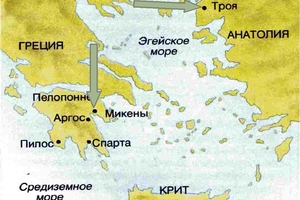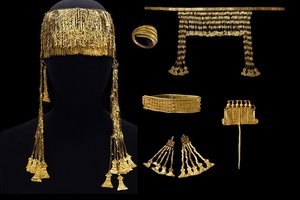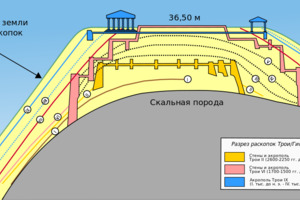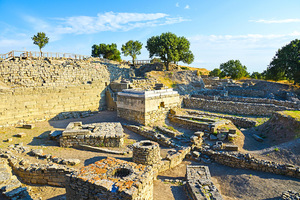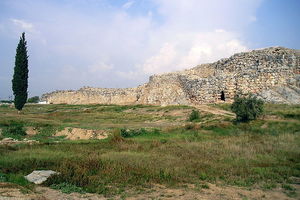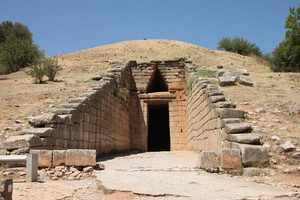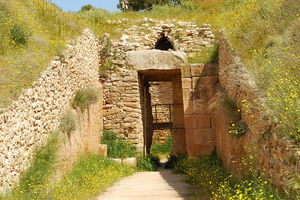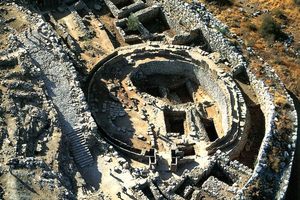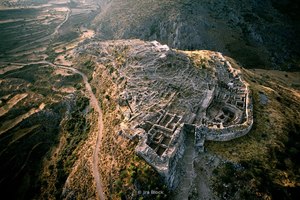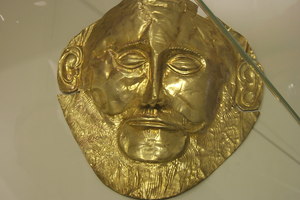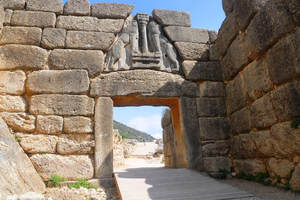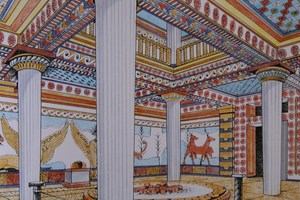Achaean States in the Second Millennium BCE
Periodization
1. Early Hellenic period (XXVIII-XXI centuries BC )
During this period, the Pelasgians, Lelegians, and Carians (pre-Greek populations) inhabited the territory of Balkan Greece. Bronze was being utilized, and there was intense societal development, with the emergence of administrative centers such as the "Citadel in Lerna."
2. Middle Hellenic period (XX-XVII centuries BC)
From the mid-3rd millennium to the 17th century BCE, the Achaeans settled across the Balkan Peninsula, assimilating with the local indigenous population. The potter's wheel appeared, as did Minoan ceramics and the use of horses and chariots in warfare.
3. Prominent Achaean states like Mycenae, Tiryns, and Pylos emerged during this period.
- XV-XIII centuries BCE: The height of the Mycenaean civilization.
- XIII-XII centuries BCE: The decline of the Mycenaean civilization.
Discovery of a the civilization
Until the mid-19th century, ancient Greek history was studied starting from the 7th century BCE (the Archaic period). Information about earlier periods was known solely from the accounts of ancient authors. This situation remained until the 1870s when Heinrich Schliemann discovered Troy in 1873. Heinrich Schliemann, a German entrepreneur, polyglot, and self-taught archaeologist, is considered one of the founders of field archaeology. His main goal was to find evidence of the existence of Troy. He believed that the events described by Homer in his poems had a basis in historical reality. Schliemann conducted excavations at Hisarlik in Turkey from 1870 to 1873, which were successful. During the excavations, he uncovered Troy beneath the ruins of a later Greek city, revealing ancient fortifications and several cultural layers dating back to the Bronze Age. This discovery led to the revelation of the Mycenaean civilization that preceded the later Archaic and Classical periods. One of the most famous finds was the "Treasure of Priam" - a collection of gold and copper artifacts discovered in May 1873. After World War II, it became part of the collection of the Pushkin Museum in Moscow. In addition to Troy, Schliemann conducted excavations in Mycenae, Tiryns, and Boeotian Orchomenos.
Social Structure
The social structure of the Mycenaean civilization was a class-based society. The majority of the population consisted of free peasant-communalists and farmers, while there were also craftsmen, sailors, and traders. Additionally, there existed a military, administrative, and priestly elite. Slave labor was used in the service of palaces, often divided into work brigades with slave overseers and subordinates. However, slave labor was not employed within the communal structures. In terms of agriculture, they cultivated grapes, olives, and grains. Land ownership varied, with the land being owned collectively by the communities, privately by aristocrats, and there was also the practice of leasing land. The main tools and weapons were made of bronze. It is worth noting the main difference between the Achaeans and the inhabitants of Crete was the emphasis on the production of weapons and military materials among the Achaeans. This can be attributed to the fact that the Achaeans, as an ethnic group within the Indo-European cultural and linguistic community, were a conquering people, hence the opposition between the surrounding nature as hostile chaos and the warrior.
Administrative and Territorial Division
Now let's turn to the governance and administrative-territorial division of the Achaeans. The Mycenaean states represented a complex system of governance institutions. The wanax was the supreme ruler, possessing the highest military, administrative, and theocratic authority. The wanax was subordinate to the lawagetas, the commander, who performed the highest military functions after the king. In addition to the lawagetas, the king had priests, telestai, damatiai, and ekestai (high-ranking officials) under his authority. There were also basileis, lower-ranking representatives in the royal organization who headed the communities. The country was divided into districts, each headed by a korēster (governor). The districts were comprised of damasoi (rural communities) where farmers and craftsmen lived. Independent city-states often engaged in wars with each other. Presumably, in the 14th century BCE, Mycenae became the hegemon in southern Greece. This made the Mycenaean state the leader of the entire Achaean world. It is through the example of Mycenae that we will examine the culture of this civilization since an entire period of Greek history is named after this city.
Mycenae
The oldest archaeological ruins of Mycenae date back to around 3000 BCE. In the Middle Helladic period (XX-XVII centuries BCE), the hilltop was fortified, and an extensive necropolis with rock-cut tombs stretched to the east. Around 1600 BCE, large-sized tombs intended for important individuals were constructed. During this period, colossal tholos tombs, consisting of a long entrance corridor and a spacious circular chamber with a conical roof, began to be built in more remote areas from the city. In the Late Helladic period, Mycenae initially came under the influence of Crete (XVII-XVI centuries BCE) but later began to develop its own culture, known as Mycenaean, which influenced all of southern Greece from the XVI-XII centuries BCE and had connections with the coastlines of the Mediterranean, from Syria to Italy. Around 1350 BCE, new, prominent fortress walls were built, encompassing an important group of royal tombs as well. This was the period of Mycenae's highest flourishing, abruptly ending with the devastation of the territory around 1200 BCE. Shortly before 1100 BCE, the citadel was also set on fire, as indicated by numerous traces of destruction and fires discovered during excavations, and the site remained almost uninhabited for a long time.
During the era of its greatest splendor, legends were woven about these lands. According to legend, Mycenae itself was founded by Perseus, the son of Zeus, who commanded the Cyclopes to build the walls with colossal blocks that can still be seen today. He was succeeded by Eurystheus, who ordered Hercules to perform the 12 labors. They were followed by the children of Pelops and Hippodamia—Atreus and Thyestes—who were associated with the cult of Olympia. After them came Agamemnon, the son of Atreus, who was killed by Aegisthus, the son of Thyestes, who became the lover of Agamemnon's wife Clytemnestra. In turn, Agamemnon's son Orestes, after various adventures, avenged his father's murder and was pursued by the Erinyes. The tragic events of this family, closely connected with the Trojan War, have come down to us through the narratives of Sophocles and Euripides. Homer places Agamemnon, the king of Mycenae, at the head of the Greeks, alongside his brother Menelaus, who became king of Sparta after marrying Helen, the daughter of Tyndareus, the king of Sparta, whom the Trojan Paris abducted and took to Troy. The destruction of so-called Troy VII, which archaeology has documented around 1240 BCE, during the peak of the Mycenaean civilization, can be linked to this mythical wave of destruction.
The tour begins with the lower city, where the necropolises are located. One of the most remote from the city and most magnificent is the Treasury of Atreus. The entrance corridor, known as the dromos, is 36 meters long, partially carved into the rock and properly defined by cut limestone blocks, leading to a door 5.40 meters high that tapers towards the top. The door is closed by two colossal monolithic lintels carved from a single stone block, with the largest weighing 118 tons. Initially, the entrance was apparently decorated with two painted half-columns, of which only the bases remain. Above the door, the surface bounded by smaller half-columns was also painted in bright colors. The surviving remnants of this decoration are now in the British Museum in London.
Next, we enter a large circular room, the tholos, with a diameter of 14.50 meters and a height of 13.20 meters, covered by a dome consisting of 33 stone rings that gradually taper towards the top. The dome was adorned with bronze rosettes, of which the holes and some fastening nails are still preserved. This tomb is undoubtedly royal and dates back to around 1330 BCE. It cannot be the tomb of the victor of Troy VII or his father.
Other tombs of the same type are found on the slopes of the same mountain, while another group is located near the city walls. Two of them, the Tomb of Aegisthus and the Tomb of Clytemnestra, are particularly noteworthy. The former is the oldest tomb of this type, dating back to around 1500 BCE, while the latter dates to around 1300 BCE. The latter was partly installed in an ancient circle of royal tombs, known as Circle B, which was accidentally discovered only in 1951. It contained 25 graves with gold and ivory artifacts dating to 1650-1550 BCE.
The citadel is surrounded by cyclopean walls made of large limestone blocks, measuring 900 meters in length and 6-8 meters in height. At certain points, their height was originally supposed to reach 19 meters. The entrance to the city, fortified by walls, passes through the Lion Gate, named after the triangular relief with two lions placed heraldically facing each other on either side of a column. The gate is protected by only four limestone blocks: two jambs, a threshold, and an architrave. Just beyond the door, remains of a granary were found, showing traces of a fire from 1100 BCE. Some of the amphorae discovered here contained charred grain. In this part of the city, to the right of the entrance and next to the granary, is the oldest circle of royal tombs, known as Circle A, with a diameter of 28 meters and surrounded by a double row of slabs. It should be emphasized that this is a rare example of a necropolis within the city walls. Normally, tombs were constructed outside the city. This type of tomb is known as a shaft tomb. It was here, between 1874 and 1876, that Heinrich Schliemann discovered five large tombs, 19 skeletons, and numerous precious and gold artifacts, including the famous funerary masks, which are now housed in the National Archaeological Museum of Athens. Schliemann believed that he had found the tombs of the Atreid dynasty, but they were later dated to 1600-1500 BCE. All the royal tombs belong to the period of Mycenae's highest prosperity.
Further, the road winds up the slopes of the mountain among the ruins of Mycenaean houses to the royal palace located at the highest point. Today, we can see the remains of a structure dating from 1400-1350 BCE, built upon the remains of a previous palace dating back to 1600 BCE. Two guardrooms precede the long corridor that leads to a large courtyard. From here, to the left, one can enter the private rooms, including a small toilet adorned with red plaster and often referred to as the bath where Clytemnestra killed Agamemnon. On the right, there is a staircase leading to the official section: the atrium leads to the throne room, and through a portico and vestibule, one could access the sacred place known as the Megaron. In the center was the hearth covered with painted plaster. Four columns supported the ceiling, of which the bases of three are still preserved. Like other palaces belonging to the same period, the entire space was presumably decorated with frescoes. The floor was also covered with colorful paintings, of which only small traces remain.
Destruction of Achaean cities
In the 13th-12th centuries BCE, the Doric invasion took place, marking the final major wave of population movements in the early period on the Balkan Peninsula. Achaeans cities fell one by one. The Dorians destroyed palace complexes and other complex economic and cultural structures in their path. As a result of the Dorian conquest, part of the Mycenaean civilization migrated to the territory of Asia Minor, part was displaced, and some Achaeans were reduced to dependent status as semi-free and enslaved individuals (perioeci, helots in Sparta).
Related topics
Ancient Greece, Archaic Greece
Literature
1. Homer. Iliad. Odyssey. Moscow: Prosveshcheniye, 1987. - 400 p.
2. History of Ancient Greece. Ed. V.I. Kuzishchin. Moscow: Vysshaya Shkola, 2003. - 399 p.
3. Sergeev V.S. History of Ancient Greece. St. Petersburg: Poligon, 2002. - 801 p.

